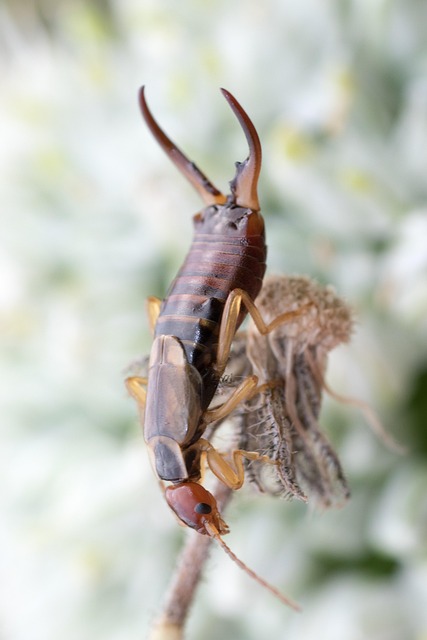Earwigs thrive in dark, moist environments like bathrooms and kitchens, attracted by moisture and organic matter. To prevent infestations, address water leaks and food debris, disrupt their living conditions through cleaning and sealing entry points, and use natural deterrents. Signs of an indoor earwig infestation include live insects, shed skins, chewed materials, and a peculiar odor. Regular inspections with sticky traps, maintaining hygiene, and using natural repellents can help manage severe cases. For comprehensive solutions, professional pest control services specializing in earwig infestation treatment are recommended. Proactive steps like sealing entry points, regular outdoor inspections, kitchen hygiene, and natural deterrents prevent future infestations.
Tired of finding unwelcome visitors in your indoor spaces? Discover how to safely tackle a persistent earwig infestation. This comprehensive guide unravels the secrets of these tiny invaders, their behaviors, and signs of a hidden invasion. We equip you with effective, yet gentle removal methods, offering practical tips for both immediate relief and long-term prevention. Say goodbye to earwigs and reclaim your comfortable living environment with our expert advice on earwig infestation treatment.
Understanding Earwigs and Their Behavior
Earwigs are small, wingless insects known for their distinctive appearance and nocturnal behavior. Understanding their habits is crucial in effective earwig infestation treatment. These pests prefer dark, moist crevices, making indoor spaces like bathrooms, kitchens, and basements ideal habitats. At night, they emerge to forage for food, often traveling along walls or floors before invading other areas. Earwigs are primarily attracted by moisture and organic matter, which makes it essential to address any sources of water leaks or food debris when attempting earwig removal.
Their behavior also includes a strong preference for solitude, making them reclusive creatures. This trait can be exploited during the removal process; sealing off potential hiding spots like cracks, gaps, and crevices can deter them from returning. Regular cleaning and maintaining a dry environment are effective earwig infestation treatment strategies that disrupt their living conditions, ultimately encouraging them to find a new habitat elsewhere.
Identifying Signs of an Indoor Earwig Infestation
Recognizing the signs of an indoor earwig infestation is crucial for effective earwig infestation treatment. One of the most obvious indicators is the presence of live earwigs or their shed skins in areas like cracks, crevices, and dark corners of rooms. These insects are attracted to moisture and often gather near sinks, bathrooms, and kitchens. You might also notice small holes chewed into fabric, paper, or other materials, as earwigs feed on plant-based items. Additionally, a peculiar odor could be present, indicating the presence of their excrement.
If you suspect an infestation, it’s essential to act promptly. Regular inspections using sticky traps can help monitor and confirm the extent of the problem. Once identified, there are several safe methods for removal. These include sealing entry points, maintaining good hygiene, and employing natural deterrents like peppermint oil or cinnamon. For severe cases, professional pest control services offering earwig infestation treatment can be engaged to ensure a thorough and long-lasting solution.
Safe and Effective Removal Methods
To safely remove earwigs from indoor spaces, it’s essential to understand effective yet non-harmful methods. One of the best approaches is to use a vacuum cleaner with a fine nozzle to suck them out. This method is particularly useful for small infestations and ensures no physical contact with the pests. Alternatively, you can apply double-sided tape or sticky traps near crevices and corners where earwigs are known to hide. These traps silently capture the insects without causing them harm.
For more persistent earwig infestation treatment, consider using natural repellents like mint oil, cinnamon, or garlic. Dilute these substances in water and spray them around entry points and infested areas. This approach is safe for both humans and pets while effectively deterring earwigs. As a last resort, professional pest control services offer safe and thorough treatments, especially for severe infestations.
Preventing Future Earwig Infestations
Preventing future earwig infestations is key to maintaining a pest-free home. After successfully removing earwigs, take proactive steps to deter them from returning. Seal any gaps or cracks in walls, windowsills, and doors with caulk to eliminate entry points. Regularly inspect outdoor areas around your property for signs of earwig activity, especially near plants, as they are attracted to moisture and organic matter. Keep your home clean and clutter-free, as earwigs are drawn to dark, tight spaces where they can hide. Implement strict hygiene practices in the kitchen, promptly cleaning up spills and ensuring food is stored securely.
Consider using natural repellents like citronella candles or lavender plants indoors to discourage earwigs from entering. Regular pest control treatments can also be effective in preventing infestations. Professional services can identify and address any existing nests while providing ongoing protection against future earwig invasions, offering peace of mind for homeowners.
In conclusion, addressing an indoor earwig infestation requires a multi-pronged approach. By understanding these insects’ behavior and identifying subtle signs of their presence, you can take proactive steps for safe removal using natural or chemical methods. Preventative measures, such as sealing entry points and maintaining cleanliness, are key to avoiding future earwig infestation treatments. With diligent care, you can create an earwig-free environment within your home.
